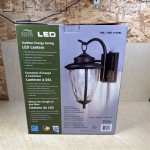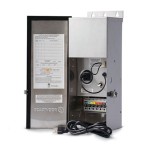Understanding Outdoor Light PIR Sensors: Functionality, Applications, and Optimization
Outdoor lighting is an essential component of modern properties, providing security, safety, and aesthetic enhancement. Among the various control mechanisms for outdoor lights, Passive Infrared (PIR) sensors have gained significant prominence due to their efficiency and convenience. This article explores the principles of operation, diverse applications, and methods for optimizing the performance of outdoor light PIR sensors.
PIR sensors are electronic devices designed to detect movement by measuring changes in the infrared radiation emitted by objects in their field of view. Unlike active infrared sensors, which emit infrared beams, PIR sensors remain passive receivers, only reacting to fluctuations in ambient infrared levels. This passive operation contributes to their low power consumption and makes them ideally suited for battery-powered applications or environments where minimizing energy usage is critical.
The core of a PIR sensor consists of two pyroelectric sensors arranged in a differential configuration. These sensors are sensitive to infrared radiation. When a warm object, such as a human or animal, moves across the sensor's field of view, it first exposes one pyroelectric sensor and then the other. This differential exposure creates a change in voltage, which is then amplified and processed by the sensor's internal circuitry. Only changes in infrared radiation are detected; a constant infrared level across both pyroelectric sensors will not trigger a response. This differential design helps to minimize false alarms caused by uniform changes in ambient temperature.
A Fresnel lens is commonly used to focus the infrared radiation onto the pyroelectric sensors, increasing the sensor's range and sensitivity. The lens is segmented into multiple facets, each acting as a small lens to direct infrared radiation from different angles onto the sensor element. This segmentation effectively expands the sensor's field of view and enables it to detect movement from a wider area. The design and placement of the Fresnel lens are critical factors in determining the sensor's detection range, sensitivity, and coverage pattern.
Key Point 1: Principles of Operation and Sensor Components
The functionality of an outdoor light PIR sensor hinges on its ability to detect changes in infrared radiation. This detection process involves several key components working in concert. The pyroelectric sensor, the Fresnel lens, and the processing circuitry each play a vital role in ensuring accurate and reliable motion detection. Understanding the interaction between these components is crucial for selecting and configuring PIR sensors for specific applications.
The pyroelectric sensor is a crystal that generates an electrical charge when exposed to infrared radiation. These crystals are extremely sensitive to changes in temperature, making them ideal for detecting the minute temperature differences caused by the movement of warm objects. The differential arrangement of two pyroelectric sensors minimizes the impact of ambient temperature fluctuations. A change in infrared radiation will trigger a voltage difference between the two sensors, initiating a detection event.
The Fresnel lens, typically made of plastic, focuses infrared radiation onto the pyroelectric sensor. The segmented design of the lens allows it to capture infrared radiation from a wide angle and concentrate it onto the sensor. This concentration significantly increases the sensor's sensitivity and detection range. The pattern of the Fresnel lens can be customized to achieve specific detection patterns, such as a wide-angle view or a long-range, narrow view.
The signal from the pyroelectric sensor is typically very weak and requires amplification. The processing circuitry within the PIR sensor amplifies the signal and filters out noise. This circuitry also includes logic that determines whether the detected signal represents a valid movement event. This logic often incorporates adjustable parameters such as sensitivity and detection delay, allowing users to fine-tune the sensor's response to different environmental conditions.
Key Point 2: Diverse Applications of Outdoor Light PIR Sensors
Outdoor light PIR sensors find application in a wide variety of settings, ranging from residential security to commercial lighting management. Their ability to automatically activate lighting upon motion detection provides enhanced security, improved safety, and reduced energy consumption. The specific application determines the ideal sensor placement, sensitivity settings, and lighting configurations.
In residential settings, outdoor light PIR sensors are commonly used for security lighting. These sensors can be integrated with outdoor lights to illuminate pathways, driveways, and entrances when movement is detected. This deters potential intruders and provides homeowners with increased visibility and a sense of security. The sensors can also be used in conjunction with security cameras to record footage of any detected events.
Commercial properties utilize outdoor light PIR sensors for similar security purposes, but often on a larger scale. Sensors can be deployed to illuminate parking lots, loading docks, and building perimeters, enhancing safety and security for employees and visitors. The sensors can also be integrated with building management systems to provide centralized control and monitoring of lighting throughout the property.
Beyond security, outdoor light PIR sensors are valuable for energy conservation. By only activating lights when movement is detected, these sensors significantly reduce energy consumption compared to lights that remain on continuously. This is particularly beneficial in areas that are not frequently used, such as storage areas or back entrances. The energy savings can translate into substantial cost reductions over time.
Furthermore, outdoor light PIR sensors can improve safety by illuminating potentially hazardous areas, such as steps or uneven terrain. This illumination can help prevent accidents and injuries, particularly in low-light conditions. The sensors can be positioned to focus on specific areas of concern, ensuring that these areas are adequately lit when someone approaches.
Another application of outdoor light PIR sensors is in landscape lighting. These sensors can be used to accentuate specific features of a garden or landscape, such as trees or sculptures. The lights can be programmed to activate when someone approaches, creating a dynamic and visually appealing effect.
Key Point 3: Optimization Techniques for PIR Sensor Performance
Achieving optimal performance from outdoor light PIR sensors requires careful consideration of various factors, including sensor placement, environmental conditions, and sensitivity settings. Proper installation and configuration are critical for minimizing false alarms and ensuring reliable detection of genuine movement. Fine-tuning the sensor's parameters can significantly improve its effectiveness in specific environments.
Sensor placement is perhaps the most critical factor influencing performance. Sensors should be positioned to maximize their field of view and to avoid obstructions that could block their detection range. It is also important to consider the direction of movement. Sensors are typically more sensitive to movement perpendicular to their field of view than to movement directly towards or away from them.
Environmental conditions can also affect sensor performance. Direct sunlight, strong winds, and heavy rain can all trigger false alarms. To mitigate these effects, sensors should be shielded from direct sunlight and positioned away from areas prone to strong winds. Some sensors are equipped with weather-resistant housings to protect them from rain and other environmental factors.
Sensitivity settings should be adjusted to suit the specific environment and application. Higher sensitivity settings increase the sensor's range and its ability to detect small movements, but they also increase the likelihood of false alarms. Lower sensitivity settings reduce the risk of false alarms but may also reduce the sensor's ability to detect genuine movement. Experimentation with different sensitivity settings is often necessary to find the optimal balance.
Detection delay is another parameter that can be adjusted to optimize performance. Detection delay refers to the amount of time that the light remains on after movement is detected. Shorter detection delays conserve energy, while longer detection delays provide extended illumination. The ideal detection delay depends on the specific application and the user's preferences.
Regular maintenance is also essential for ensuring optimal performance. The Fresnel lens should be cleaned periodically to remove dust and debris that could obstruct the sensor's field of view. The sensor's batteries should be replaced regularly to ensure that it continues to operate reliably. Following these maintenance procedures will help to prolong the lifespan of the sensor and maintain its effectiveness.
Finally, consider upgrading to more advanced PIR sensor technologies. Some newer sensors incorporate features such as dual-element detectors, which are less susceptible to false alarms caused by temperature changes or small animals. Other sensors use advanced signal processing algorithms to further reduce the risk of false alarms and improve detection accuracy.
By understanding the principles of operation, considering the diverse applications, and implementing optimization techniques, users can maximize the effectiveness of outdoor light PIR sensors and enjoy the benefits of enhanced security, improved safety, and reduced energy consumption.

Auraglow Pir Motion Sensor Up Down Outdoor Wall Security Light Warminster Stainless Steel Led Lighting

Astrid Outdoor Wall Light With Pir Sensor Anthracite Litecraft

Auraglow Dusk Till Dawn Daylight Pir Motion Detection Sensor Outdoor Wall Light Wharton Dorton Silver Led Lighting

Delisha Pir Charcoal Grey Cage Effect Outdoor Wall Light Fra104 The Lighting Super

Asher Outdoor Wall Light With Pir Sensor Stainless Steel Bhs

Modern Stainless Steel Outdoor Light With Pir Sensor 6211

Pir Sensor Security Outdoor Wall Lantern Value Lights

Up And Down Pir Motion Sensor Wall Light For Outdoor Use

Auraglow Black Arch Integrated Led Motion Sensor Pir Outdoor Wall Light Adobe Lighting

Wallace Outdoor Wall Light With Pir Sensor Black Bhs
Related Posts







